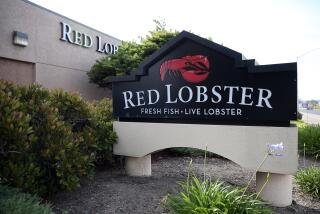Biologists Harvest Larger, Meatier Crop From Lobster ‘Farm’
- Share via
SAN DIEGO — Biologists-turned-businessmen Jack Van Olst and James Carlberg have big hopes for their lobster farms, where through manipulation of water temperature and other environmental factors they are growing meatier lobsters that could boost the availability and lower the price of the shellfish delicacy.
Work that began a decade ago when the two were biology researchers at San Diego State University has progressed to the point where the business of growing better lobsters, striped bass and catfish has overshadowed the scientific work.
“We wanted to see that our ideas actually worked on a large scale, and that kind of work doesn’t really fit in a university. They like to work in 10-gallon tanks and research-sized operations,” Van Olst said at the Sorrento Valley headquarters of Aquatic Systems Inc.
Since the business began in 1979, Van Olst and Carlberg have proved that their research theories can work on a large scale.
With a $40,000 federal grant and proceeds from successful fish ventures they started in the laboratory, the two are concentrating on refinements to their cultured lobster farms. More grants are likely to follow, Carlberg said.
Working with imported East Coast lobsters, Van Olst and Carlberg have successfully persuaded some lobsters to suspend their molting process, or growth, by keeping them in cold water. Others have been persuaded to speed up their development by keeping them isolated in warm water.
Neither process is a breakthrough in itself. But it is difficult to coordinate the use of hot and cold water environments, keep the water clean and oxygenated, and the animals properly fed and individually stored, Carlberg said.
“The problems that remain in the culture of lobsters from egg to market size in captivity are primarily nutrition and engineering,” he said. “One problem is that the animals are highly cannibalistic when held under very high densities.”
Carlberg said 15% to 20% of the annual commercial lobster catch is lost to cannibalism and disease each year. A lobster culture farm could drastically reduce that loss, he said.
Such a farm is about five years away. By then, the two hope to be able to grow lobsters from eggs to market size in two years, compared to the seven years it takes naturally.
“What we’ve been able to do is take temperature-controlled growth, and by keeping the animals in very cold water, we can inhibit molting so we have a hard-shell, fully meated animal and we eliminate that mortality loss from the fishery,” Carlberg said.
The use of warm water speeds up the lobster’s development and can cause a molt, or shedding of the exoskeleton, every few months. By taking on water and eating from processed food pellets in its holding area, the lobster grows a new skeleton over its increased bulk.
“We can take an animal that’s maybe a pound and make him roughly a pound and a half,” Carlberg said. “So now you’ve had a manipulation of a wild resource that’s fully exploited at around 30 million pounds and we might be able to add another 10 million pounds to that.
“Right now we are just able to take animals from the wild and improve upon survival and perhaps add weight. Ultimately we can take one adult--she may carry a couple hundred thousand eggs--and if we just get 10% survival, we may add to the resource many times over what we’ve already done, just by adding 40% in weight.”
Prices May Come Down
An increase in the supply could bring lower prices, but more important, it could replenish the finite amount of lobster left in the wild from overfishing, Van Olst said.
“We’re working with a group that is involved in lobster holding and distribution on the East Coast and are very interested in applying this technology,” Carlberg said. “They have already begun applying some of the cold water applications for molt inhibition.”
As Americans continue to eat more seafood and less beef, Carlberg and Van Olst think their business can only grow. Their culture work with striped bass and catfish already brings in a third of the income for the privately held Aquatic Systems Inc., with grants and consulting fees making up the rest.
“We’ve done a variety of laboratory experiments on (catfish) reproduction, hybridization, nutrition, communal versus individual rearing, confinement stress and what effect that has on growth rate, and we’ve done descriptive flavor analysis on the cultured versus the wild product and found no significant difference,” Carlberg said. “There’s a very high marketability.”
Even though Aquatic Systems Inc. sold $37,000 worth of catfish in May, potential investors are more impressed with the thought of buying in on a lobster farm because it sounds better, Van Olst said.
More to Read
Sign up for Essential California
The most important California stories and recommendations in your inbox every morning.
You may occasionally receive promotional content from the Los Angeles Times.













